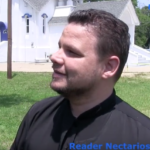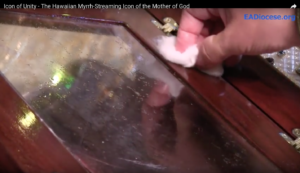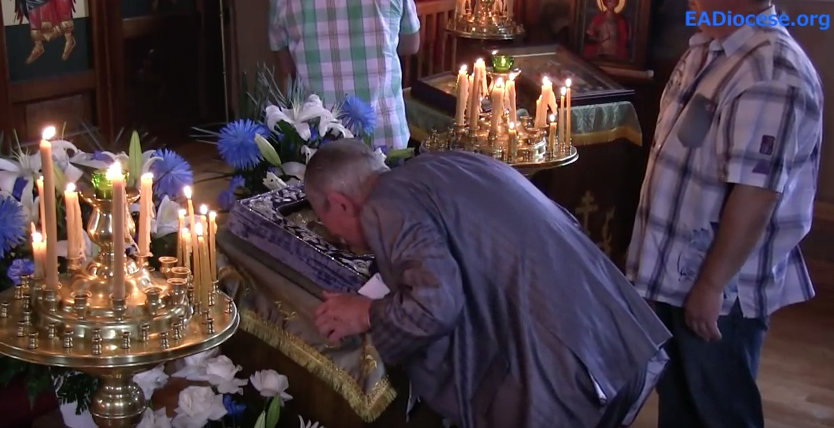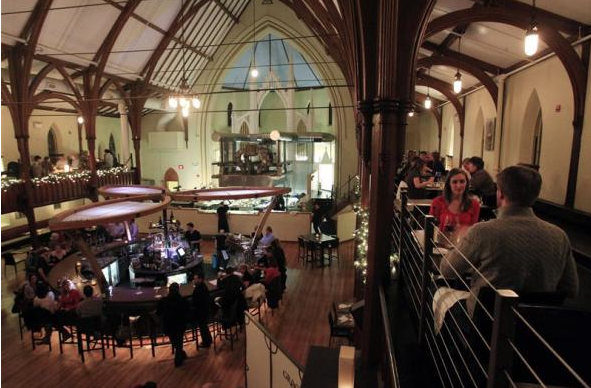Recently, there has been an increase in dialogue between Reformed Christians and Orthodox Christians about icons. Much of it has been of an intellectual nature focused on the Bible and the early church fathers, but what is one to make of miraculous icons? These pose a different kind of challenge to Christians who are accustomed to using logic and reason in theological debates.
I just received this from one of our readers, JM Burnham, who wrote of his encounter with miraculous icon in June 2016:
This past Sunday in my parish church, Holy Apostles (ROCOR) in Beltsville, Maryland, we had the distinct honor of welcoming the Hawaiian Iveron Myrrh-streaming Icon. As our dear Metropolitan Hilarion (First Hierarch of the Russian Church Abroad) was celebrating the Divine Liturgy, everyone came up to the Icons of the church-temple and venerated them. The myrrh-streaming Icon, which I named above, was actually streaming myrrh and giving off one of the loveliest odours of holiness I had ever witnessed; i.e., like roses mixed with a myriad of other odorous flowers, but a hundred times more fragrant and soothing.
Having said that, I have sadly encountered several [D]eformed Protestants who said that “It’s nothing more than Devil’s work! Satan’s deceiving you to get you to worship your idols and forget about Jesus!” Instead of taking it upon themselves to investigate further, I’ve noticed that such persons immediately dismiss any miracles in the Orthodox Church (let alone actively myrrh-streaming icons) as trickery from the Evil One. They then point their fingers at us Orthodox Christians saying that we’re guilty of idol worship and so many other “sins” against God. It is well-known that many Protestants, even some traditionalist Roman Catholics, don’t even believe that we Orthodox are actually Christians – but that’s a topic for another discussion.
The main point I’m trying to convey is anecdotal, yet strongly grounded in existential reality and interpersonal experience. For me, I felt confirmed in my faith as an Orthodox Christian. Seeing this miraculous icon actually helped me to realize some very important realities that I had been taking for granted, but not appreciating as deeply as I ought:
Icons are not “idolatrous pictures of dead saints,” as most mainline Protestants would call them. These sacred “pictures” amplify, and bring home the reality of, the Incarnation of the God-man, Jesus Christ. In particular, myrrh-streaming icons, such as the Hawaiian Iveron Icon as aforementioned, demonstrate the approval of the Holy Spirit, for it is only the Holy Spirit Who could bring about such secular-logic-defying, clearly supernatural occurrences. It is almost always (about 95% of the time) Icons of the Theotokos that tend to be miraculous. This demonstrates Mary’s critical role in God the Word’s [historical] Incarnation as well as the incarnational reality of the Church, Christ’s Mystical Body; after all, the Church Fathers looked upon Mary as the purest figure of the Church. Moreover, after venerating the myrrh-streaming icon, I realized in a more profound way that the Orthodox Church truly is the Body of Christ, in both time and eternity, in heaven and on earth, against which “the gates of hell shall [have] not prevail[ed]” (Matthew 16:18).
I just wanted to share this little story with everyone to help bring home the profoundly simple truth of the Orthodox Faith concerning Icons. As a side note, I’m a recovering Roman Catholic, and I sometimes still struggle with some of the negatives effects that Roman Catholic heresy has had upon my heart, mind, body, and soul. Such miraculous icons can only be witnessed in canonical Orthodox Churches. They do NOT exist in the Roman Catholic church or in the Protestant communities; moreover, they definitely do not exist in any other religious expression (non-Christian) known to mankind. Orthodoxy is indeed unique; it is deeply supernatural and a living Faith that has no equals.
Comment from Robert
I know this icon. Living in Hawaii, I visit the Russian Orthodox Church often and most of the time I will see this icon on the stand up in front. The icon is what I would call a quiet miracle. When I stand before it, I can see oily streaks on the glass cover and smell the flowery fragrance emanating from the icon. The first time I saw the icon I was surprised by the absence of drama. Yet, as I stood before it, I found myself amazed at this inexplicable phenomenon. It was as if God opened this window to heaven just a tiny bit, allowing the fragrant scent of heaven to flow over into our fallen world that is so desperately in need of His mercy.
There are stories of people being healed miraculously after being anointed by the oil coming from this icon. But then, there are many who have not been healed after seeing this icon. These healing miracles are a gift from God, but they are not the main point. With respect to miracles, Orthodoxy is not cessationist. (Cessationaism is the heresy that miracles ceased with the death of the last of the original Apostles.) We believe that miracles can happen, even today. The main point of Orthodox icons is to draw us closer to Christ. When I stand before the miraculous Iveron icon, I see the Virgin Mary pointing her hand to Jesus. I am reminded of her total commitment to her Son and our God. I reflect on her words: “Whatever He says to you, do it.” (John 2:5)
I would not advocate using miraculous icons as a means of refuting the Reformed tradition’s iconoclasm. The better approach is to appeal to Scripture and the witness of the church fathers. Nonetheless, the miraculous Hawaiian icon does pose a challenge to the secular, disenchanted worldview so prevalent among Reformed and Evangelical Christians. Fr. Stephen Freeman described this particular outlook in his recent post “The Disenchanted World”:
Where people of earlier eras and other cultures have experienced the world around them as charged with divine power (of various sorts), we simply experience the world as inert. There is nothing there.
Secularism has affected, not just the way Protestants view nature, but also the way they approach conversion. The Protestant reduction of the Gospel to mere “rational choice” avoids, if not obviates, conversion being a super-natural work of the Holy Spirit. The empirical nature of this miraculous icon cannot be refuted by means of logic and syllogism.
 Reader Nectarios Yangson who is tasked with guarding the icon noted:
Reader Nectarios Yangson who is tasked with guarding the icon noted:
It is the grace of the Holy Spirit visibly showing itself upon us. It is something tangible: we can touch; we can taste; we can feel. [See “Icon of Unity” at 7:25]
An encounter with the Hawaiian miraculous icon and others like it – Yes, there are other miraculous icons! – is like a short visit to the enchanted world of the kingdom of God suffused with the divine presence.
In the Bible, visible tangible miracles are often used to validate a spiritual claim. In Mark’s Gospel Jesus prefaced the healing of the paralytic with: “But that you may know . . . .” (Mark 2:10) The beneficiaries of the healing miracle were not just the paralytic lying on the pallet, but also the Pharisees and teachers of the Law who doubted Jesus’ authority to forgive sins. Not all miracles are from God; therefore, miracles need to be subjected to spiritual tests, e.g., Is Jesus Christ glorified? Is his coming in the flesh affirmed? Is the Church, the Body of Christ, edified? Are sinners converted? The atmosphere surrounding a miraculous icon should be a faith-filled one like in Luke 5:26: “And they were all amazed, and they glorified God and were filled with fear, saying, ‘We have seen strange things today!’”
Miraculous icons also serve as notice to prospective converts that conversion to Orthodoxy entails more than an intellectual acceptance of the Seventh Ecumenical Council and the writings of early church fathers like John of Damascus and Theodore the Studite. It involves a transition from a detached, intellectual approach to Christianity to one of an embodied mysticism that is sensuous and otherworldly at the same time. One does not gawk at a miraculous icon. The Orthodox response to this miraculous icon is one of veneration mixed with love and affection. We gather at church; we sing hymns honoring Mary; we ask Mary to be our prayer partner to Christ; and we line up to kiss her icon. This is what the Seventh Ecumenical Council had in mind when they affirmed the veneration of icons. One way to venerate the Hawaii Iveron icon is to kiss Mary’s hand which points to her Son and then to kiss Christ’s feet. In honoring the mother we honor her Son, and in honoring our God Jesus Christ we honor his mother Mary who made possible the miracle of the Incarnation.
A friend once expressed disappointment that she had missed seeing the miraculous icon. I pointed out that all icons are special, and, that this miraculous is not more sacred than the others. It is just that God chose to use this particular icon to manifest his grace in a visible, tangible way to weak, sinful people like us. With the other “ordinary” icons God’s grace is invisible; we respond to this unseen grace through an act of faith. This means we don’t have wait for a miraculous icon to come to our neighborhood. Just go to the nearest Orthodox parish!
In closing, the miraculous Hawaii icon is a sign that the kingdom of God has come near, that we need to repent and turn to God. This call to repentance applies to the Orthodox just as it does to Reformed and Evangelical Christians. So if the Hawaiian miraculous icon does come to your area, don’t hesitate to visit the icon. It is God’s gift of mercy to Orthodox and non-Orthodox. As Philip said in response to Nathaniel’s skepticism: “Come and see!”
Robert Arakaki
RESOURCES
Article: “Iveron Icon of the Blessed Virgin Mary Visits Our Assumption of the Blessed Virgin Mary Church.”
Video: “Icon of Unity – The Hawaiian Myrrh-Streaming Icon of the Mother of God.” [Reader Nectarios at 7:25]
Video: NECN News Report “‘exuding’ icon draws thousands to Massachusetts.”
Video: “Opening Hawaii Icon”
Article: “The Disenchanted World.” Fr. Stephen Freeman. Glory to God for All Things, 22 July 2016.






Recent Comments